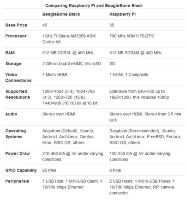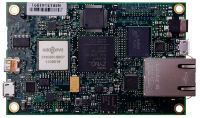Is anyone here rocking a Cubieboard or Hackberry or anything of the sort? Been looking at some RaspberryPi alternatives that offer the same cost erformance ratio (I don't mind if it costs more so long as the increase in cost is reflected by the increase in performance). What do you guys think?
erformance ratio (I don't mind if it costs more so long as the increase in cost is reflected by the increase in performance). What do you guys think?
You are using an out of date browser. It may not display this or other websites correctly.
You should upgrade or use an alternative browser.
You should upgrade or use an alternative browser.
Raspberry Pi alternatives? What do you guys think?
- Thread starter MannDude
- Start date
Since I've gotten my raspberry pi, I've been what you could call obsessed with embedded computing and trying to find the best cost/performance/usability ratio.
There is a not so popular company based out in Israel called solid-run that makes a 2 inch cube with a 1ghz quad core ARM processor (without overclocking) as opposed to a 1 core 700mhz core with the raspberry pi.
http://cubox-i.com/
I'm actually looking forward to picking one up whenever Newegg starts carrying them within the next 2 weeks or so. The included wifi/bluetooth/ir adds alot of capability in that small package. I will likely have a dedicated ssh / irc system running on it using a fraction of the power my computer uses now.
Edit: After spending about $100 for a raspberry pi with all the peripherals to actually get it so its not just a bare board hanging around, its should be fairly obvious that $124 for essentially the same thing with better specs would be the way to go. The cubox includes the case, connectivity, micro sd card and power cable
There is a not so popular company based out in Israel called solid-run that makes a 2 inch cube with a 1ghz quad core ARM processor (without overclocking) as opposed to a 1 core 700mhz core with the raspberry pi.
http://cubox-i.com/
I'm actually looking forward to picking one up whenever Newegg starts carrying them within the next 2 weeks or so. The included wifi/bluetooth/ir adds alot of capability in that small package. I will likely have a dedicated ssh / irc system running on it using a fraction of the power my computer uses now.
Edit: After spending about $100 for a raspberry pi with all the peripherals to actually get it so its not just a bare board hanging around, its should be fairly obvious that $124 for essentially the same thing with better specs would be the way to go. The cubox includes the case, connectivity, micro sd card and power cable
Last edited by a moderator:
wlanboy
Content Contributer
The Raspberry Pi is quite in the middle between the $200 all-you-can-eat boards (like the PandaBoard) and the Arduino clones for $10.
There is one board that I would buy if I did not have a Raspberry Pi: The BeagleBone Black for about $45.
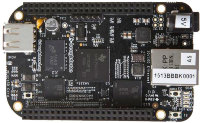
If you compare them:
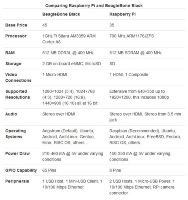
BeagleBone elec. connections:
Another nice looking board is the Cosmic Board:

If I would have more free time I would buy the Parallella board.
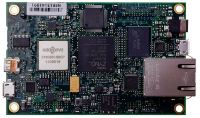
This is about a ARM A9 processor which has got access to a Epiphany chip which consists of a scalable array of 16 RISC processors programmable in C/C++ connected together using a shared memory architecture.
So this little board has a FPGA and an array of 16x700Mhz = 11.2 Ghz processor grid.
If you are able to get your c++ code using all the cores.
But a perfect and cheap start into massive parallel computing.
Edit: Added the BeagleBoard black image.
There is one board that I would buy if I did not have a Raspberry Pi: The BeagleBone Black for about $45.

If you compare them:

BeagleBone elec. connections:
- 3 I2C buses
- CAN bus
- SPI bus
- 4 timers
- 5 serial ports
- 65 GPIO pins
- 8 PWM outputs
- 7 analog inputs
- 8 GPIO pins
- 1 UART interface
- 1 SPI bus
- 1 I2C bus
Another nice looking board is the Cosmic Board:

The Cosmic+ Board supports the VF6xx with multi-core ARM® Cortex™-A5 and Cortex™-M4. The Cortex-M4 is supported by Freescale MQX. MQX is a Real-Time Operating System (RTOS) providing real-time performance within a small, configurable footprint.
If I would have more free time I would buy the Parallella board.

This is about a ARM A9 processor which has got access to a Epiphany chip which consists of a scalable array of 16 RISC processors programmable in C/C++ connected together using a shared memory architecture.
So this little board has a FPGA and an array of 16x700Mhz = 11.2 Ghz processor grid.
If you are able to get your c++ code using all the cores.
But a perfect and cheap start into massive parallel computing.
Edit: Added the BeagleBoard black image.
Last edited by a moderator:
I'd like to get a box of these - http://hardkernel.com/main/products/prdt_info.php
Unfortunately when i checked they had a limit of one per customer + stupid shipping fee.
Unfortunately when i checked they had a limit of one per customer + stupid shipping fee.
Taronyu
New Member
Arduino clone for $10? Where? I'm still searching a way to setup a small clustered netwerk here for learning purposes.The Raspberry Pi is quite in the middle between the $200 all-you-can-eat boards (like the PandaBoard) and the Arduino clones for $10.
There is one board that I would buy if I did not have a Raspberry Pi: The BeagleBone Black for about $45.
If you compare them:
wlanboy
Content Contributer
Ebay and cheap China resellers are your best friends.Arduino clone for $10? Where? I'm still searching a way to setup a small clustered netwerk here for learning purposes.
drmike
100% Tier-1 Gogent
My Pi is taxed. Runs the VPN... Runs Squid... Runs some other proxy and filtering inline.
Overall, the throughput straight remote network is lacking and CPU ceiling and above gets hits quick and hard. Definitely in the market for something with more oomph and ability to push bits faster with overhead for processing things.
The Pi isn't bad for what I am doing. Exception is the one image resizer inline that gets ill and slogs with these modern designer idiot layouts and 500 elements.
Overall, the throughput straight remote network is lacking and CPU ceiling and above gets hits quick and hard. Definitely in the market for something with more oomph and ability to push bits faster with overhead for processing things.
The Pi isn't bad for what I am doing. Exception is the one image resizer inline that gets ill and slogs with these modern designer idiot layouts and 500 elements.
Shados
Professional Snake Miner
I'd wait a while on the Parallella - I'm an original kickstarter backer and mine has yet to arrive. They have at least started production a couple of weeks ago, but yeahhhh.The Raspberry Pi is quite in the middle between the $200 all-you-can-eat boards (like the PandaBoard) and the Arduino clones for $10.
There is one board that I would buy if I did not have a Raspberry Pi: The BeagleBone Black for about $45.
If you compare them:
BeagleBone elec. connections:
RaspberryPi elec. connections:
- 3 I2C buses
- CAN bus
- SPI bus
- 4 timers
- 5 serial ports
- 65 GPIO pins
- 8 PWM outputs
- 7 analog inputs
And the BeagleBone board is open source - so you can use it for any projects you want.
- 8 GPIO pins
- 1 UART interface
- 1 SPI bus
- 1 I2C bus
Another nice looking board is the Cosmic Board:
If I would have more free time I would buy the Parallella board.
This is about a ARM A9 processor which has got access to a Epiphany chip which consists of a scalable array of 16 RISC processors programmable in C/C++ connected together using a shared memory architecture.
So this little board has a FPGA and an array of 16x700Mhz = 11.2 Ghz processor grid.
If you are able to get your c++ code using all the cores.
But a perfect and cheap start into massive parallel computing.
On a related note, I have an odroid-u3, and it's pretty nice. Not as cheap as it looks because power cable/case/(microsd|eMMC) aren't included, and you also really need the IO shield if you want to do electronics stuff, but still quite nice.
wlanboy
Content Contributer
Currently there are two main hypes floating around:I'm surprised by the seeming lack of quad-core boards like these at this point. Phones have been packing such.
Lack of proper disk interfaces is unappealing also.
- minimal always on desktop machine
- technical/electronics hobbyist playground from LED to quad-copter and robots
If you want to have something mobile they offer you Ultrabooks and tablets.
If you want to have something with a lot of drives they offer you NAS machines that are able to run a lot of stuff.
If you want more network connections they offer you routers that can run OpenWRT.
The niche with FPGAs (Field Programmable Gate Array) is filled with Parallella and other FPGAs like Alan.
The niche with a lot of GPIOs is set with the BeagleBoard and copy cats.
If you need more cores you can check Wandboard: Cortex-A9 Quad core with 2 GB of RAM or the OrigenBoard.
Or even an eight core monster with a Cortex™-A15 1.6Ghz quad core and a Cortex™-A7 quad core CPU.
peterw
New Member
BeagleBone Black is eating the Raspberry Pi for launch. More pins more power and the operating system is on board. The SDCard can be used for data only to save its life. I like the Arduino universe and the great community. You find code and shields for everythings. I will buy the pcDuino V3.

Items
Details
CPU
AllWinner A20 SoC, 1GHz ARM Cortex A7 Dual Core
GPU
OpenGL ES2.0, OpenVG 1.1, Mali 400 Dual Core
DRAM
1GB
Onboard Storage
4GB Flash, microSD card (TF) slot for up to 32GB
Video Output
HDMI 1.4 with HDCP support
OS
Arduino extension interface
Arduino sockets, same as Arduino UNO
14xGPIO, 2xPWM, 6xADC, 1xUART, 1xSPI, 1xI2C
Network interface
Audio out
LCD
LVDS
IR
IR receiver
SATA
SATA Host socket
Camera
MIPI
Battery
Li-Poly Battery Interface
USB
2xUSB host, 1xUSB OTG
Power
5V, 2000mA

Items
Details
CPU
AllWinner A20 SoC, 1GHz ARM Cortex A7 Dual Core
GPU
OpenGL ES2.0, OpenVG 1.1, Mali 400 Dual Core
DRAM
1GB
Onboard Storage
4GB Flash, microSD card (TF) slot for up to 32GB
Video Output
HDMI 1.4 with HDCP support
OS
- Ubuntu 12.04
- Android 4.2
Arduino extension interface
Arduino sockets, same as Arduino UNO
14xGPIO, 2xPWM, 6xADC, 1xUART, 1xSPI, 1xI2C
Network interface
- USB WiFi
- Ethernet 10/100/1000Mbps
Audio out
- 3.5mm analog audio interface
- I2S stereo digital audio interface
LCD
LVDS
IR
IR receiver
SATA
SATA Host socket
Camera
MIPI
Battery
Li-Poly Battery Interface
USB
2xUSB host, 1xUSB OTG
Power
5V, 2000mA
Last edited by a moderator:
peterw
New Member
My RPi arrives tomorrow! First on the agenda is rebuilding my HTPC. Next project is plug my pair of 3TB drives into a dual bay USB enclosure and RAID1 those fockers.
Cavalry has a great USB Raid dock: http://www.cavalrystorage.com/en-cahdd-d.aspxRAID1 over USB sounds like a bad idea. You will split the already small USB bandwidth in half.
Code:
With a choice of 4 modes, you can set up your hard drives in any available configuration for your needs.
Choose RAID 1 to mirror two drives for data protection,
RAID 0 for speed,
JBOD for flexibility, or
Spanning (BIG) for increased capacity.
Last edited by a moderator:
I have been using Olinuxino imx233 and A10/13/20 devices from Olimex. All of the boards can run Linux and their price range is from 22 EUR to 65 EUR (+VAT) depending on the features.
For example, currently I have one Olinuxino-imx233-maxi (64MB RAM, 454MHz CPU, custom Linux distribution) running as home dns server, and one Olinuxino-A20-micro (Allwinner A20, dual core Cortex-A7, 1GB RAM, SATA interface, Debian 7.x armhf) as file server.
For example, currently I have one Olinuxino-imx233-maxi (64MB RAM, 454MHz CPU, custom Linux distribution) running as home dns server, and one Olinuxino-A20-micro (Allwinner A20, dual core Cortex-A7, 1GB RAM, SATA interface, Debian 7.x armhf) as file server.
peterw
New Member
Olimex is a great company I will buy one of the Olinuxino boards.I have been using Olinuxino imx233 and A10/13/20 devices from Olimex. All of the boards can run Linux and their price range is from 22 EUR to 65 EUR (+VAT) depending on the features.
For example, currently I have one Olinuxino-imx233-maxi (64MB RAM, 454MHz CPU, custom Linux distribution) running as home dns server, and one Olinuxino-A20-micro (Allwinner A20, dual core Cortex-A7, 1GB RAM, SATA interface, Debian 7.x armhf) as file server.
OLINUXINO is completely open source - including hardware and software, this means you have access to all CAD files and sources and you can reuse them for your own personal or commercial project.
This is a beast for only 35€. SATA,native ethernet, 5V compatible and 160 GPIOs on four GPIO connectors!I also ordered one of the Olimex devices to test it - A10-OlinuXino-LIME and it looks very good. I will consider making some micro servers from these, in addition to the Raspberry Pi.
Power managment is great:
Code:
A10-OLinuXino-LIME can be powered from three sources:
+5VDC voltage applied PWR jack
+3.7V from LiPo re-chargable battery connected to LiPo board connector
+5V applied to USB-OTG connector
Power consumption is as follows:
LiPo 3.7V power battery: 1.2W
+5VDC input power: 1.3W
Code:
LiPo battery allow backup power supply when main power is interrupted.
A10-OLinuXino-LIME have power managment IC which charge the battery when main power is present,
when power is interrupted the LiPo battery automatically provide backup power supply.
Step-up converter prvide 5V for the USB peripherials too.@peterw the bet part - Olimex is a Bulgarian company and these boards are made here. It is always great to be able to support the local business 
Just the GPIO connectors are too tiny for my liking (1.27 mm pin to pin spacing instead of the normal 2.54mm), but i guess you just can't fit 160 pins in such small space otherwise.
Just the GPIO connectors are too tiny for my liking (1.27 mm pin to pin spacing instead of the normal 2.54mm), but i guess you just can't fit 160 pins in such small space otherwise.
peterw
New Member
I am surfing their website for over one hour. Great products. I found a adapter for breadboards: https://www.olimex.com/Products/OLinuXino/A10/A10-OLinuXino-LIME-UEXT/open-source-hardwareJust the GPIO connectors are too tiny for my liking (1.27 mm pin to pin spacing instead of the normal 2.54mm), but i guess you just can't fit 160 pins in such small space otherwise.
Looks like A10-Olinuxino-LIME is out of stock from olimex.com. However, you can order it from resellers like exp-tech.de: http://www.exp-tech.de/Mainboards/OLinuXino/A10-OLinuXino-Lime.html (LIME is even cheaper there, thanks to smaller VAT in Germany).

